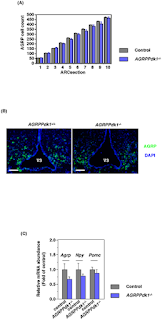A possible new slant for combating obesity
The researchers in this study acheived a sustained increased PYY3-36 (a neuropeptide) expression via viral vector-mediated gene delivery targeting salivary glands and the good news: this increase resulted in a significant long-term reduction in food intake (FI) and body weight (BW). This is evidence for new functions of the previously characterized gut peptide PYY3-36 suggesting a potential simple and efficient alternative therapeutic approach for the treatment of obesity: Andres Acosta1, Maria D. Hurtado1, Oleg Gorbatyuk, Michael La Sala, David Duncan, George Aslanidi, Martha Campbell-Thompson, Lei Zhang, Herbert Herzog, Antonis Voutetakis, Bruce J. Baum, Sergei Zolotukhin. Salivary PYY: A Putative Bypass to Satiety. PLoS ONE 6(10): e26137. doi:10.1371/journal.pone.0026137. Received: July 22, 2011; Accepted: September 20, 2011; Published: October 10, 2011...Rabbit anti-Y2R (Dilution: 1:3000) using TSA...
Images: A) Immunolocalization of Y2R-positive cells in the hippocampus of C57Bl/6J mouse (WT), a (+) control. (B) Immunolocalization of Y2R in the tongue epithelia of Y2R KO mouse, a (-) control. VEG – von Ebner's gland. (C) Immunolocalization of Y2R-positive cells in the CV area of the tongue of a C57Bl/6J mouse. (D) close-up of (C). (E), and (F) close ups of (D), top and bottom rectangles, respectively. doi:10.1371/journal.pone.0026137.g003
These findings could prove a first step in identifying new targets for obesity fighting therapies. Increasing PYY salivary output would provide satiety with less food intake. This would give a whole new perspective on dieting. If we are satsified with less food intake is this really dieting? Stay tuned.
Scientists grow retina cells from skin-derived stem cells
-
WASHINGTON - University of Wisconsin-Madison researchers have successfully
grown multiple types of retina cells from two types of stem cells, giving
new ho...
16 years ago




























